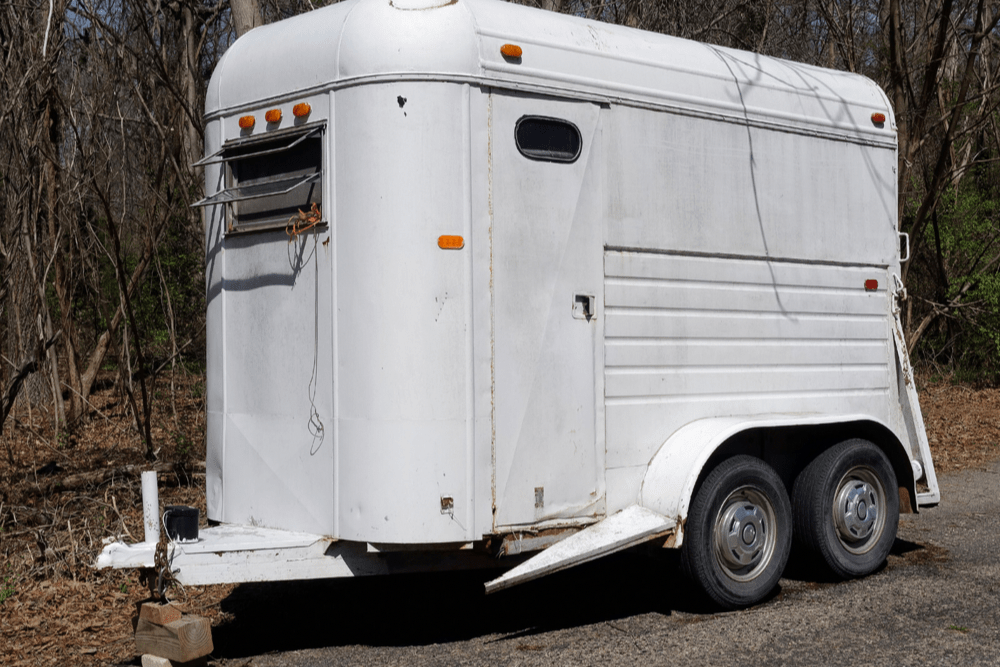Goats and sheep are often one of the first types of livestock animals that homesteaders keep on the homestead when they are first starting out. Chickens are normally the first animals that are kept, and then goats and sheep close on their heels. So if you are a new homesteader and you have acquired some goats or sheep, you may wonder how to safely transport your sheep and goats.
Transporting a single goat or sheep is best done in a large dog carrier to keep the animal contained and secure. For transporting groups, a purpose-built trailer is ideal. An enclosed trailer is preferable. Keep trips slow and short, and take the animal’s needs into consideration at all times.
Owning livestock on the homestead is a goal that most homesteaders move towards as they expand their activities and want to start producing their own milk, meat, and products that can generate and income on the homestead. This is a great aspiration to have, but it comes with some logistical challenges when you need to transport these animals for various reasons.
Why You Would Need To Transport Goats And Sheep
There are a few reasons that may arise on the homestead where you may need to transport your goats and sheep. The first time that you may need to transport the animals is when you initially purchase your first animals and need to collect them from the seller.
You may be able to arrange that the seller delivers the animals as part of the purchase price, but this may not always be the case. You would then need to make arrangements to get your livestock to your homestead.
Another instance where you may need to transport these animals is when you need to take individual animals to the vet for treatment. With smaller livestock, it is generally cheaper if you take the animal to the vet as opposed to getting the vet to make a housecall!
The final time that you may need to transport these animals is if you sell any of them or take any of them to be processed for meat. This may require a number of animals to be transported at the same time.
How To Transport Individual Goats Or Sheep
The easiest transporting of goats and sheep from a logistical point of view is the transporting of an individual animal at a time.
The manner in which you tackle this problem will depend on the size of the goat or the sheep. If the animal is young, it could be transported inside a normal sedan or the cab of a pickup truck. Wrapping the young animal in a blanket and having a passenger sit and hold the animal on their lap will help to keep the young one calm.
If you keep dwarf goats and you need to transport an adult from your herd, then the best method is to use a carrier cage or dog crate that you would normally use to transport a medium-size dog to the vet.
This type of carrier would easily fit on the back of your pickup truck, and the animal would have space to lie down inside the carrier. A dog kennel that has a door fitted to it will also work for transporting the smaller sized sheep or goat.
For the larger goats or sheep, having a pickup truck with railings that extend the height of the sides and back works well to keep the animal contained. Just make sure that the tailgate remains secure and does not pop open during the trip.
You can place some bales of straw in the back of the pickup truck to provide a comfortable place for the animal to lie down or to protect the animal from falling against the sides of the truck during transport.
If you have a minivan or an SUV, the back loading-space of these vehicles makes an ideal transport space for a single adult goat or sheep. It keeps them nicely contained with minimal space for them to fall against hard sides or objects.
Travelling is stressful for goats and sheep, especially when they are being transported alone. They will experience stress from being separated from their herd, from being in an unfamiliar environment, and if they are sick, this will be an added stress factor.
Many people find that if they talk to their goats and sheep in a soothing voice or even sing to them, it helps to calm them down and reduce the stress levels.
How To Transport Groups Of Goats Or Sheep
Transporting groups of animals brings with it a new set of challenges that you need to consider when moving your goats and sheep from place to place.
You will need to give significant consideration to the following aspects of the transport to make sure the animals travel with as little stress as possible and arrive in good condition at the end of the trip.
- How many animals should you pack into the transport space?
- How long is the trip going to take?
- Do you need to supply food and water?
If you are only transporting a few goats or sheep, in the range of 2 to 5 animals, you could transport them on the back of a pickup truck if the sides have been elevated by the addition of railings.
Place some hay in the back of the pickup to give them some cushioning as well as something to eat. It may be worthwhile to place a tarp over half of the load bay towards the cab of the vehicle. This will reduce the draft and give the animals some shelter. Ensure that the tarp is secured so that it does not flap around and further stress the animals.
For larger numbers of animals, a purpose-built trailer is the best option. The trailer should be a double axle trailer to provide better suspension, a smoother ride for the animals, and prevent any accidents should you have a blow-out on a trailer tire.
Enclosed trailers similar to a horsebox are preferable to open trailers since goats, in particular, suffer cold stress, which can lead to mortalities.
Do not pack the animals in too tightly so that there is not enough room for an animal to lie down without being trampled by the others. The numbers of animals that you can fit in the trailer will need to be determined on a case-by-case basis, depending on the mix of sizes of animals in the group.
Do not undertake long trips without catering for rest times for the animals. An hour on the road being transported is the equivalent of two hours of walking for a goat or sheep. The constant moving of the vehicle causes them to constantly re-adjust the weight to keep their footing and to stop themselves from falling over. This can be exhausting for the animals, especially younger or weaker animals.
Make sure you include some bales of food in the trailer since this will give the animals something to do and help to distract them. Do not leave water in the back, but if your trip is going to be longer than three hours, you need to plan a stop to water the animals.
Dehydration is a major problem with transporting these animals since the stress of the trip often causes them to urinate excessively, thus hastening the dehydration. Plan for frequent water stops and carry enough water for the herd for the duration of the trip.
Some Driving Tips For Transporting Goats And Sheep
When you are towing a trailer with livestock, you need to be cognizant of your cargo throughout your trip and adjust your driving to minimize the stress and exhaustion of the animals.
- Pull-off slowly so that you do not frighten the animals by the sudden movement.
- Avoid sudden, sharp braking.
- Drive slowly. This avoids excessive jostling among the animals and helps to minimize the wind to prevent cold stress.
- Take corners slowly to help the animals retain their footing and prevent any unnecessary injuries.
Conclusion
Raising livestock on the homestead is a great goal and one that most homesteaders will get around to doing at some point.
Transporting these animals is often a neglected consideration and often rushed when the realization comes that it is not as simple as simply putting them in the back of a pickup and driving off.
Transporting goats and sheep takes some planning and forethought, but if you give it enough consideration and keep the wellbeing of the animals as the highest priority, you should have minimal problems when transporting your goats and sheep.

